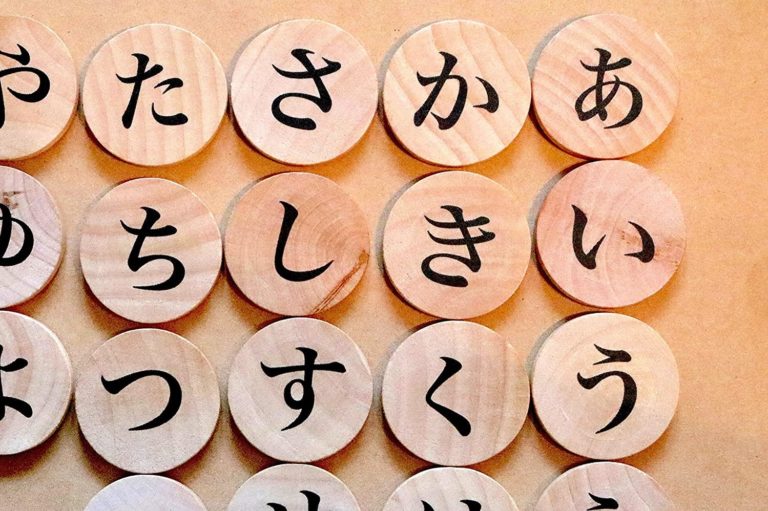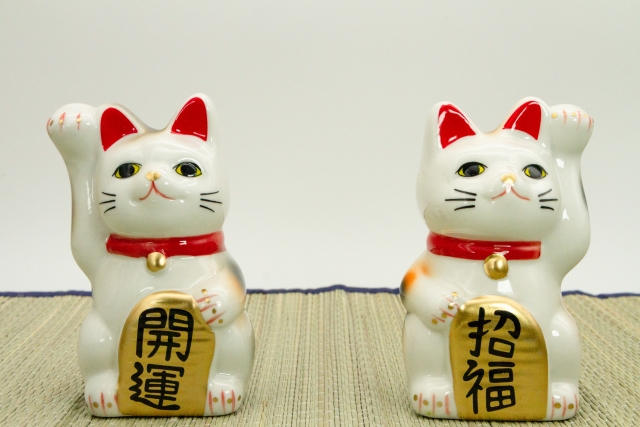Living in Japan, have you ever heard of the event called Shichi-Go-San?
Shichi-Go-San is a celebration that makes you feel happy about something, even though you are not sure what it means for a child.
The memory of eating those long Chitoseame candies and having sekihan (red rice) cooked is a day of celebration that will stay with them forever.
In this page, we will look at the meaning, origin, and related topics of Shichigosan.
What is the meaning and origin of Shichi-Go-San?
First, let’s look at the meaning of Shichi-Go-San.
The point is that it is a combination of three events.
Click here to learn Japanese language with the best one-on-one Japanese tutoring lessons in person or online.
Contents
What is the meaning of Shichi-Go-San?
Shichi-Go-San is an event to celebrate the growth of children when they turn 3, 5, and 7 years old. There are differences in the ages of celebration for boys and girls, but generally the following combinations are common.
| Age | Boy | Girl |
| 3 years old | ○ | ○ |
| 5 years old | ○ | - |
| 7 years old | - | ○ |
In addition to this
- Only 5 years old for boys, 3 and 7 years old for girls
- Boys and girls can be 3, 5, and 7 years old.
The “correct age” is often “X” years old. It is often said that “the correct age is…”, but in my opinion, there is no such thing as “wrong” because it is a celebration.
Rather, I think it is preferable to celebrate at all ages for both men and women.
Children look so cute in kimonos.
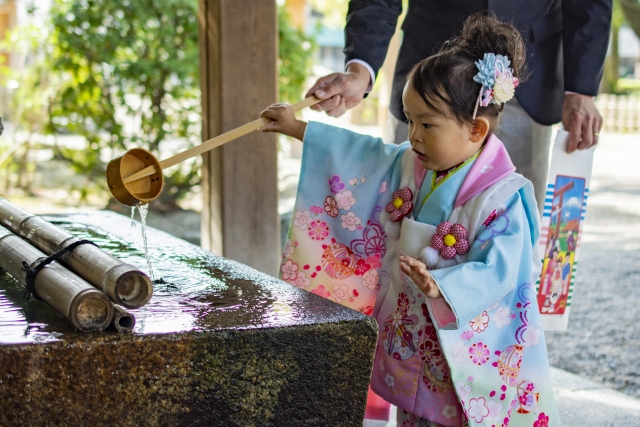
What is the meaning of each age?
Today, “Shichi-Go-San” is considered as one event. And it is held as if there are three target ages.
However, in the old days, the three-year-old event, the five-year-old event, and the seven-year-old event were separate events, as shown below.
Kamioki-no-gi (Hair-placing ceremony): 3 years old
In ancient times, it was customary for children to shave their hair until they were three years old. This event is meant to mark the end of the shaving and the beginning of growing out the hair. Both boys and girls performed this ceremony.
Hakamagi no gi (ceremony of putting on the hakama): 5 years old
This is an event for boys to start wearing Hakama (traditional Japanese male dress). This is also called “Chakko.
Obi ki no gi (ceremony of releasing the belt): 7 years old
This is an event for girls to start wearing a kimono with an obi (sash) instead of a kimono with strings.
It is also called “Himo-mitoki,” “Himo-meshi,” and “Himo-doshi.
These three different events are combined and called “Shichi-Go-San.
Some say that the reason why the ages of 3, 5, and 7 are chosen is because odd numbers tend to be preferred in Japan.
In the past, the event was held according to the counted age, but now that the full age has become widely accepted, it is often not necessary to stick to the counted age.
Especially in the case of families where brothers and sisters are close in age, it is acceptable to be flexible and celebrate one of them with the full age and the other with the counted age together.
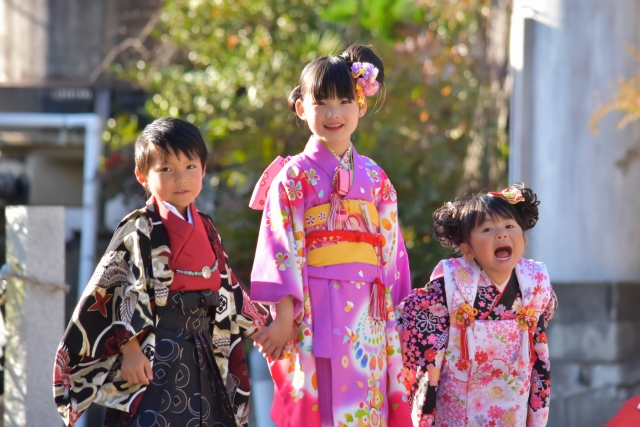
What is the origin of Shichi-Go-San?
The origins of each of the three previously mentioned events are believed to date back to the Heian period (794-1185).
However, the most popular version of the origin of Shichi-Go-San is that on November 15, 1681 (December 24, 1681), Tokugawa Tsunayoshi, the fifth shogun of the Edo shogunate, prayed for the health of his eldest son, Tokumatsu.
This led to the spread of the custom during the Edo period (1603-1867), mainly among samurai families. In the Meiji period (1868-1912), it became popular among the general public as a celebration to wish for the growth and happiness of children, and is said to have taken on a form similar to that of today.
Shichi-Go-San is now practiced throughout Japan, but the early version is considered a regional custom in the Kanto region. Shichi-Go-San is a local custom in the Kanto region, but the early version of Shichi-Go-San was a local custom in the Kanto region.

When (in which month) is Shichi-Go-San held?
As Tsunayoshi Tokugawa chose November 15, the date of Shichi-Go-San has a meaning.
In the lunar calendar, November is the month when the harvest is over and we give thanks to God for the harvest. The 15th is the day of the full moon. On this day, people give thanks for the harvest and for the growth of their children.
The 15th of every month on the lunar calendar is also the day of the devil’s lodging (Shikishukubi), which is auspicious for all events except for weddings.
For these reasons, it was held on November 15, but after the calendar was changed in the early Meiji period, it came to be held on November 15 of the new calendar. In Japan, many events are held on the same date of the old calendar as that of the new calendar.
However, there is no need to be too particular about this date. In fact, most of them are held on Saturdays, Sundays, or national holidays in November, or on any other convenient date.
In cold climates, it is often held one month earlier, on October 15.
It is said that the 15th was chosen because 7+5+3=15, but this is only a myth.
As mentioned earlier, the total number of 15 is a coincidence, since each of them was a separate event.
About Chitoseame for Shichi-Go-San
Chitose-ame, which is eaten on Shichi-Go-San, is said to have originated during the Genroku era (1688-1704) of the Edo period (1603-1868), when it was sold by a candy seller named Nanabei in Asakusa, Edo (present-day Tokyo).
It is said that Chitose Ame was first sold by Nanabei, a candy seller in Asakusa, Edo (present-day Tokyo) during the Genroku period (1688-1704), in the hope that children would grow up healthy and live a long life.
The long red-and-white candy bars are considered auspicious, and the traditional designs on the bags include the words “Kotobuki” (longevity) and “Matsutake Ume” (pine, bamboo, and plum), cranes and turtles symbolizing longevity (cranes live for a thousand years and turtles live for ten thousand years), and a lieutenant and an ubba (a woman in Takasago), all depicting auspicious symbols.
Unlike today, when the infant mortality rate was high, parents must have been very eager to celebrate Shichigosan to wish for their children’s longevity and future.
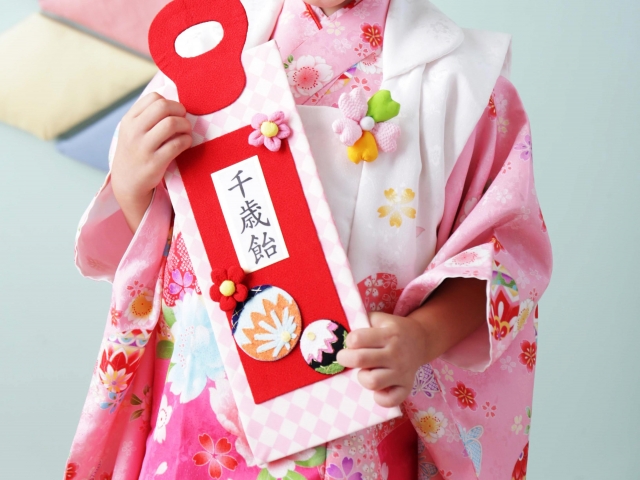
Conclusion
- Originally, “Shichi-Go-San” was a separate event for 3-year-olds (Kamioki-no-Gi), 5-year-olds (Hakamagi-no-Gi), and 7-year-olds (Obi-No-Gi).
- The origin of Shichi-Go-San is said to be a prayer made by Tsunayoshi Tokugawa, the 5th shogun of the Edo Shogunate, for the health of his eldest son, Tokumatsu, on November 15, Tenwa 1.
- Chitose-ame is made with wishes for the healthy growth and longevity of the child, and the bag is decorated with the characters for “Kotobuki” (longevity), “Shochiku-ume” (pine, bamboo and plum), “Tsurukame” (crane and turtle), “Takasago no Jyo (lieutenant) and Uba (a woman),” and other auspicious symbols.
Related article:



